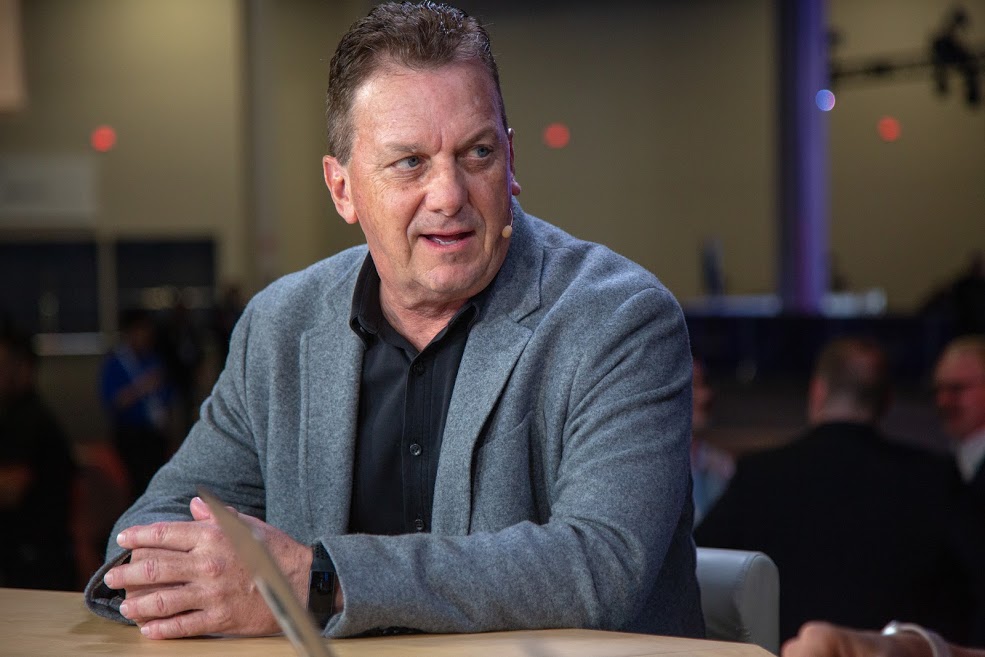 INFRA
INFRA
 INFRA
INFRA
 INFRA
INFRA
As businesses seek help transforming their data operations in a tech-driven world, they rely on partners to help with software’s shifts and cloud management.
Dell EMC is one key partner helping businesses transform. But the company itself has faced many challenges as the tech industry’s reliance on cloud applications grows. The biggest challenge has been ensuring its customers can shift to new platforms with as little effort as possible. It’s ultimate goal is a “one-click upgrade button,” according to Lewis Newcomb (pictured), vice president of hyperconverged infrastructure engineering and server and infrastructure systems at Dell EMC.
Newcomb spoke with Rebecca Knight (@knightrm) and Stu Miniman (@stu), co-hosts of theCUBE, SiliconANGLE Media’s mobile livestreaming studio, during the Dell Technologies World event in Las Vegas. They discussed the company’s latest appliance launch for VxFlex, why it’s so popular among Dell customers, and the challenges the company is facing from the public cloud sector (see the full interview with transcript here). (* Disclosure below.)
[Editor’s note: The following answers have been condensed for clarity.]
Knight: We’re talking about VxFlex. Tell us about your news today.
Newcomb: The big news this week is that we’ve launched an appliance. So traditionally we do a rack-level product with VxFlex — think half-rack without networking — and then we did some updates to our software. We’ve also added some more platforms. We added the 840 PowerEdge server, so all our products are on PowerEdge servers, and we have a great platform for SAP HANA.
Knight: Let’s walk through VxFlex customers. What are their needs, and why is VxFlex their choice?
Newcomb: You start out with a customer that’s transforming their business. They want their software to be defined. They want to prepare themselves for the future. Well, that’s where we start. We’re software defined, and the next thing we look at is if they need performance. Do they need one millisecond latency across 50 nodes? 1,000 nodes? We can do that. We’re very high performance.
The other thing is they may not want to use just vSphere. They might want to use other hypervisors, so we support those as well, and then the real interesting thing is two-layer, because as you know, with HCI, we combine the application and the stored services all on one node, so in our product we can actually separate those so you can scale storage and compute separately and it’s all still in one storage pool. It’s a very flexible product that fits that kind of customer’s needs.
Miniman: Talk about the application. You’ve talked about some of the new areas, like containerization. Is this platform that the customer really builds ready for that environment, and how do we span from what I have and where I’m going?
Newcomb: We just launched our CSI plugin, so we have some customers already testing that beta. And because we have bare metal, we can also support that in its native environment, so most customers are still using that in a virtualization environment, but they’re preparing for the future. They’re looking at different options, so it gives them that flexibility if they want to go bare metal.
Knight: What are you thinking about for the next few years?
Newcomb: We’re still building out some of the storage services. We just added compression, so our launch this week was compression. And we’ll add more and more storage services, more data protection, more replication. We’ll continue in that path — and more and more management. The management is going to be a key focus area for us.
Miniman: When I’m running in any of the public clouds, I don’t have to think about what version I’m running. In the old days, the VCE days, it was the compatibility matrix and then RCM documentation. How are we doing towards getting to that simple push button? I take care of it, securities patches come, and I don’t have to worry about scrambling?
Newcomb: That’s nirvana. That’s our north star. We’re working on that, and we’re using the Flex manager as that platform. And more and more, we’re taking those requirements in the Flex manager and we’ll be rolling it out. Our goal is to have that one-click upgrade, right? That one button. Our goal is to be able to do compliance and quick updates, and it’s a journey, and it’s the most complex part of the solution.
Knight: How do you manage that? As you said, it’s a huge challenge that both you and your customers are facing.
Newcomb: We have a lot of smart people, and we have great customers. The nice thing is that Dell is direct. The interaction we’ve had with customers this week, I mean they’re designing with us, they’re telling us what they need. And we’re not a large-scale business in relative to a server business or using computing, so we have relationships with almost all our customers, and we go and show them our roadmaps. We go get feedback from them, they help us define what they need, and we follow our customers.
Watch the complete video interview below, and be sure to check out more of SiliconANGLE’s and theCUBE’s coverage of the Dell Technologies World 2019 event. (* Disclosure: Dell Technologies Inc. sponsored this segment of theCUBE. Neither Dell nor other sponsors have editorial control over content on theCUBE or SiliconANGLE.)
THANK YOU